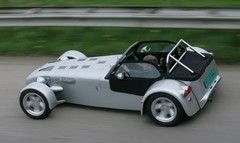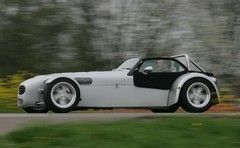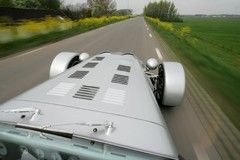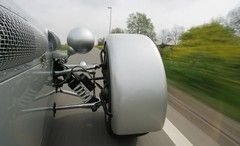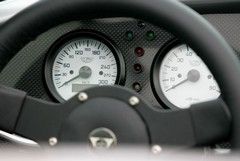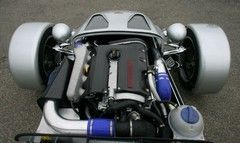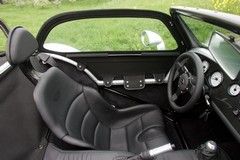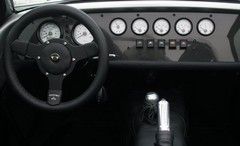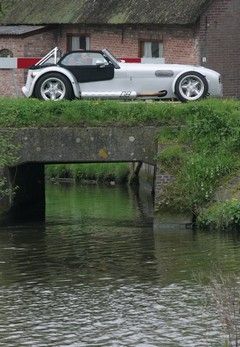Donkervoort D8
Nick Hall grabs this high-powered Caterham-alike by the scruff of its neck.
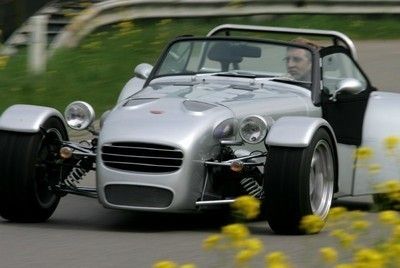
Donkervoort D8
Caterham’s CSR was launched in a blaze of publicity earlier in the year and left us in no doubt that, should we fancy an evolution of the Lotus Se7en clone, this was the one to go for. But there is a more exclusive alternative from the land of tulips and reasonably priced love: the Donkervoort D8.
Just down the road from the hazy, British tourist-filled streets of the world’s most famous Red Light District, Donkervoort has been knocking out rather special versions of Colin Chapman’s classic for 27 years now. It, too, is prevalent throughout European racing and has evolved more or less in parallel with our own well-loved sportscar manufacturer.
It even has a slightly more powerful option to the madhouse CSR 260, the 270bhp RS. That’s based on the pocket rocket that the Dutch company recently used to slash 15 seconds off the Porsche Carrera GT’s hard won Production Car record at the Nordschleife.
Just how ‘production’ that car was is a bone of contention, especially in the Stuttgart region, as it came equipped with bigger wings than Batman. But it still destroyed the ultimate road car and proved that all the horsepower and tricky clutches in the world are no match for a well-balanced and lightweight chassis. Chapman would have liked that car.
Practical proposition?
With 210bhp at its disposal, it’s an obvious rival for the lesser-powered CSR, except for one thing. In this configuration, the car costs a mind-boggling €85,000. That’s basically double the price of a CSR260 when you’ve finished importing it.
Donkervoort sells the D8 as a Grand Touring Se7en. It has real boot space and is slightly more comfortable, but only slightly. My lasting impression of the CSR260 was the unbelievable heat soak through the dashboard frame, but mainly from that exhaust running down the side. It was a laugh riot and a great car, but with the hood up it was a mobile sauna.
The Donkervoort is an improvement and, if I had to do 1,000 miles in either car, it would be this one every time. Neither is built for serious distance work, although some hardy soul will undoubtedly take issue in the forum, and the GT claim sounded a little optimistic, but this is certainly more complete than its British counterpart.
Each Donkervoort is hand-built, using a steel tubular spaceframe with copper welds, with its lattice structure comfortingly exposed on the interior and an aluminium and carbon-fibre body.
The seats come with a slot for each leg, it’s that snug in the interior. As for styling, the Biggles-laced leather in our test car was a bit, well, Dutch, but Donkervoort will deck the whole place out with ostrich feathers if you’ve got the cash to pay for it. It’s all tailored and, while the CSR’s dash looked like a stunning vision of the future on the press pictures, the ham-fisted welds on the test car I was presented with on my trip to Dartford left no doubt that the Donkervoort has more than a mild edge in the fit and finish department.
As for the performance gaps, you could just about separate the D8 and the new CSR 210 with a Rizla. The Donkervoort weighs in at 630Kg, hits 62mph in four seconds and tops out at 148mph. So it’s on a par with the CSR, but the way it gets there is a whole different story.
Motive power
While the Cosworth is a fine engine, the Audi 1.8 Turbo lurking under the lightweight bonnet is a peach. It needs to be driven above 3,000rpm, change up as the boost kicks in and the D8 will bunny hop down the road like a learner on a first lesson. In full flight, though, it’s a rocket.
In the big, well-insulated A4, this turbo powerplant mustered a mild chirrup when the waste-gates opened. Here it sounds like someone’s sneezed into the microphone while announcing a delay on the Circle Line. It will hit 7,000 revs and the four-cylinder has a more polished sound than the violent CSR.
The Audi unit is relatively bullet-proof and the performance upgrades, including a new intercooler and oil cooling system, won’t worry the internals. The 270bhp version on the road now is based on exactly the same powerplant and Audis aren’t known for falling apart under the bonnet, so this one should run forever.
A five-speed Borg Warner ‘box transmits the power to the road and, kept on boost, the acceleration is predictably electrifying. There’s no traction control, of course, just a long throttle travel and a limited slip diff with a 40 per cent locking capability to keep you safe.
That saves accidental burnouts at traffic lights and turns a track-honed weapon into a useable weekend road warrior, but drop the gas hard enough from a standing start or into bends and the 15-inch Toyo rear tyres will pop before they grip.
Driving it
A tiny Momo racing wheel feels bolted to the wheels and turn-in is telepathic. It takes some muscle at low speeds, but the payoff in high-speed feel is more than worth it. If you’re tempted and happy to spend this much money on a Se7en clone in the first place, tick the box for the quicker 2.7-turn rack as the opposite lock potential of this car is limitless.
The Donkervoort is predictable, smooth and relatively friendly on the limit. Like the Seven, it's fun for everyone, and seriously quick in experienced hands.
Hardened, drilled and grooved Tarox brake discs come unmolested by electronics and it’s down to you if you want to slow the car sensibly or lock them up and inflict 200 metres worth of tarmac abrasion to one spot of rubber. With a car this light it never feels uncontrolled and when it needs to, it can stop in a heartbeat.
As for the suspension, it’s a traditional set-up as opposed to the new CSR’s in-board mounting. The genius part is that height and rebound are fully adjustable courtesy of handgrips, you don’t need tools to give the tortured undercarriage some breathing space on the road. At the track just twist for skateboard rigidity and away you go.
The ultimate question
Now the million dollar question, is it worth the extra cash? Well it just can’t be can it?
A Caterham is a plaything, a weekend toy. You can live with a knobbly weld, a bit of heat soak and even an engine that sounds a little gruff if you’re having so much fun on the road that tears are welling in your eyes. It’s a Caterham, not a 5 Series, and the objective scale of four-wheel judgement goes out the window.
Plus, knowing all that extra cash is still in your pocket to pay for track days, which might be a less enjoyable proposition in a car that costs almost £60,000 + import tax, makes this an almost impossible equation. Yes it’s a better car, but not that much better. What price exclusivity? In this case, it’s just a little too high.
Pictures by Chris Schotanus
But the level of finishing is much higher than every other Se7en clone I've seen so far.
Been to the factory (which is NOT located near the Amsterdam red light district, but in Lelystad) twice and was impressed by how beautiful the frames were welded (soldered) together.
Also the location of the headlights is much prettier than that of the other Se7ens, which all have headlamps that look like the eyes of landcrabs.
I've driven an older Donkervoort D8 Cosworth myself, and can tell you that it's very very very very fast! The sound of the wastegate is just addicting!
But are they worth the money? It's a car that has very limited use. It's hard to get in and out, it's very tempting to drive MUCH too fast, and you will hardly be accepted at classic car meetings and the likes.
They are great cars though...
Gassing Station | Caterham | Top of Page | What's New | My Stuff

